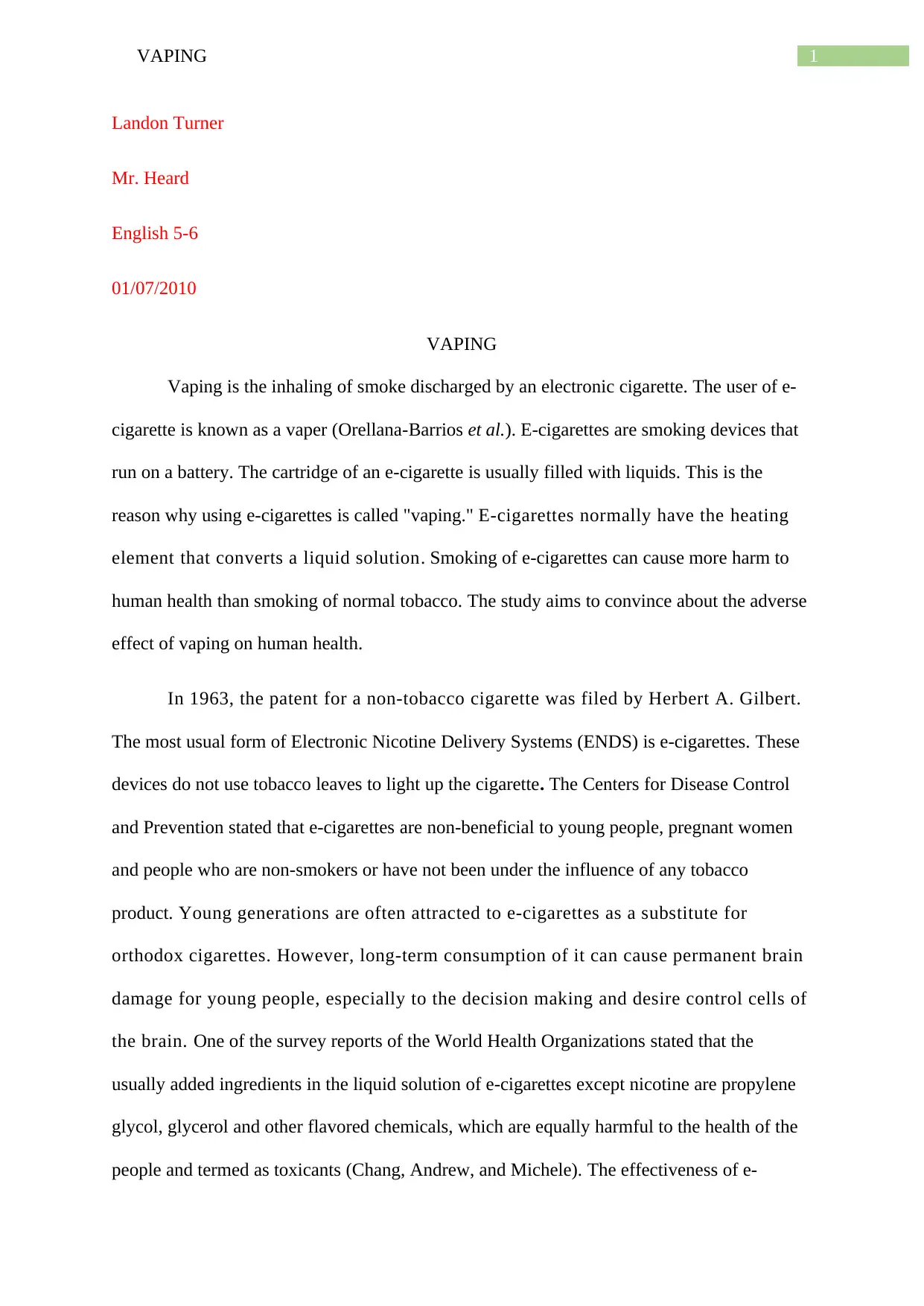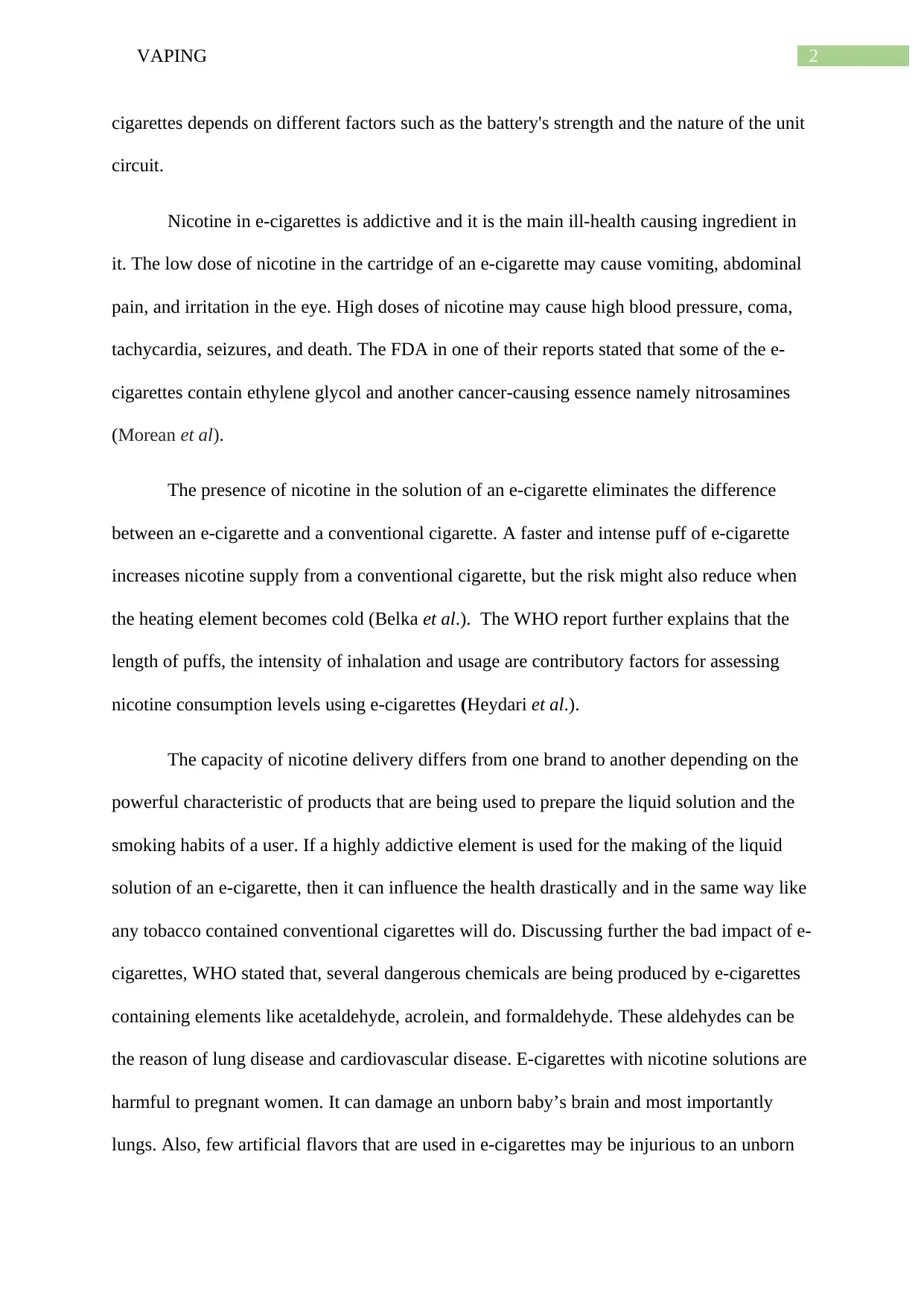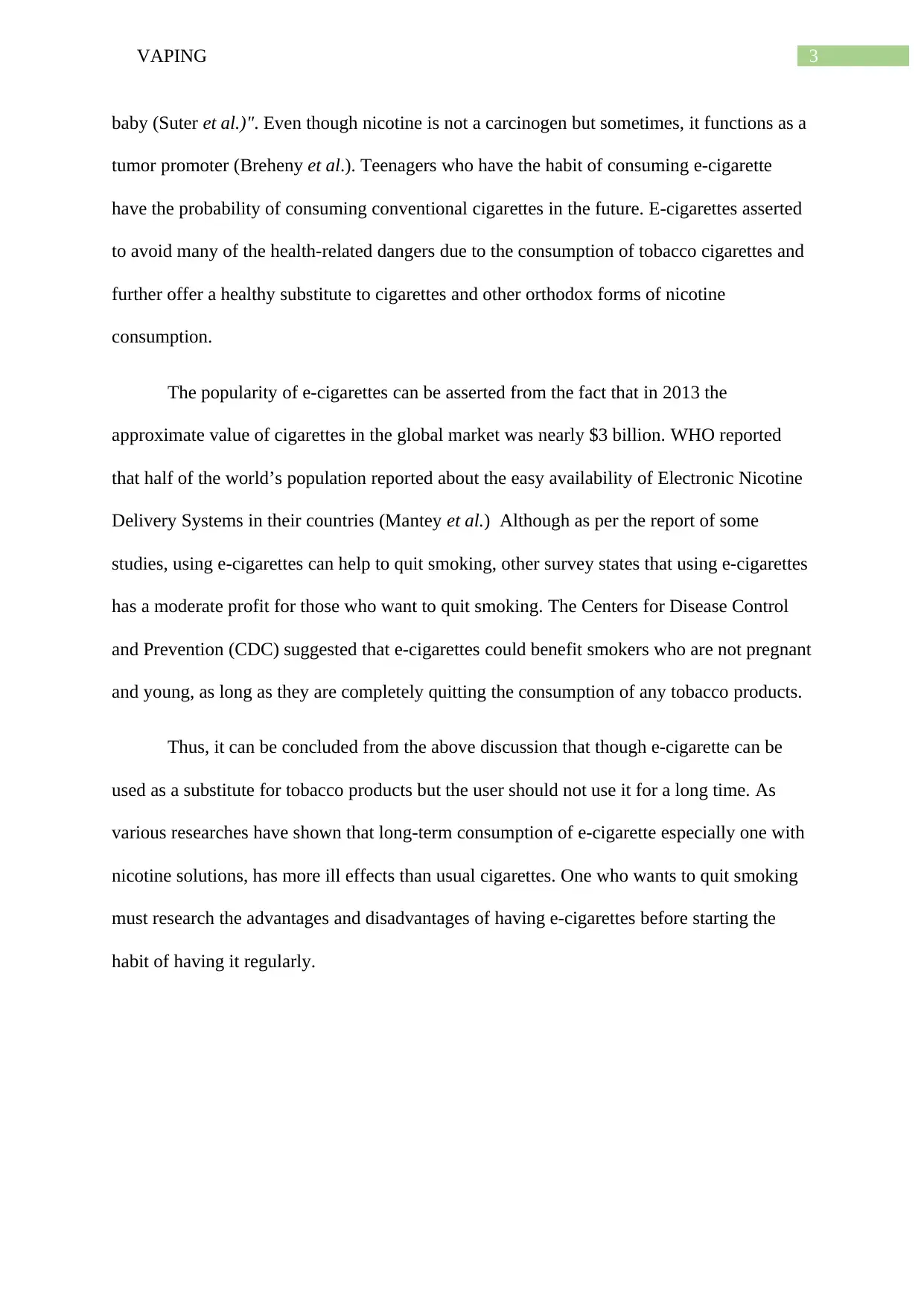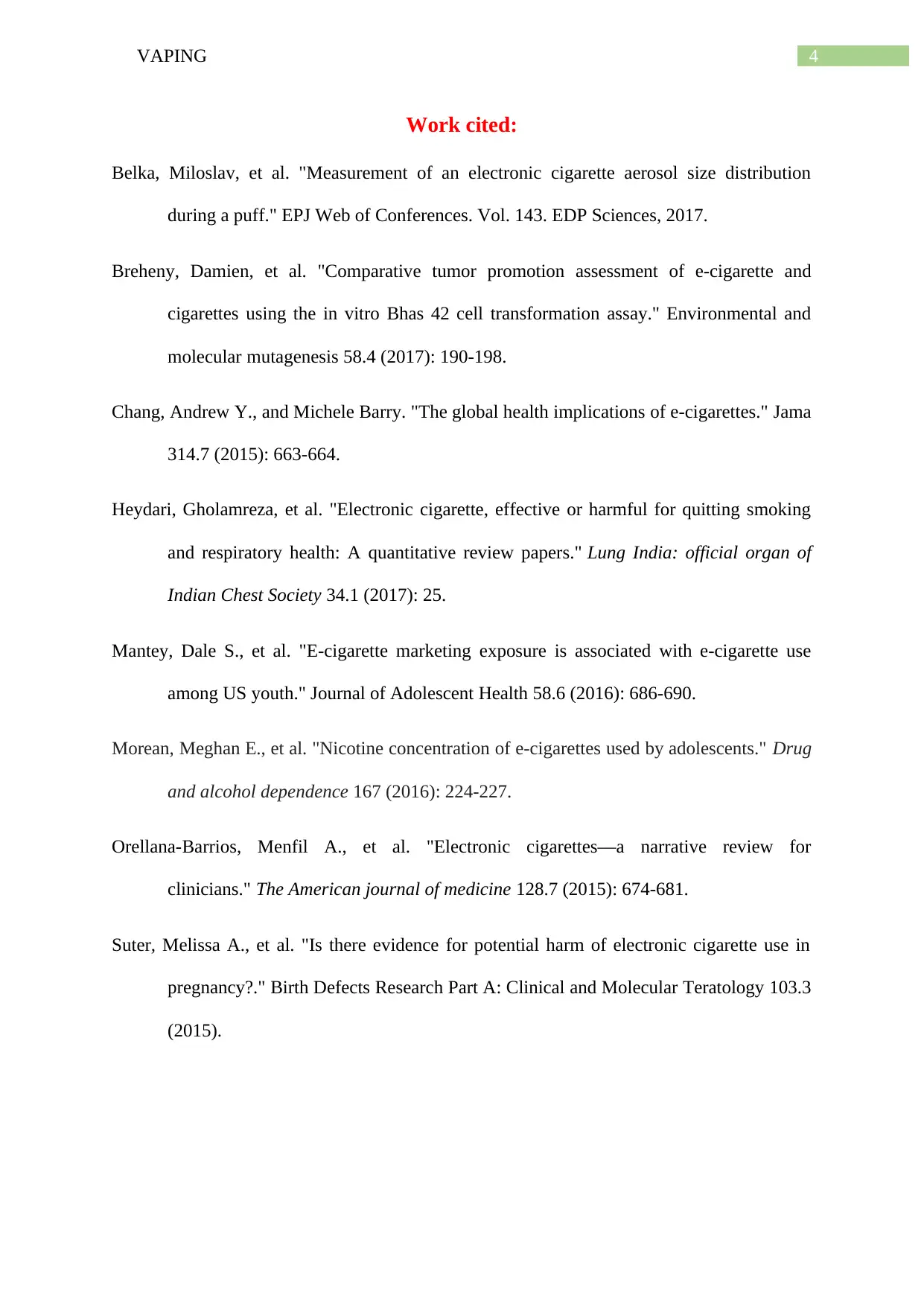Why You Should Quit Vaping: Examining the Adverse Health Effects
VerifiedAdded on 2022/08/27
|4
|1222
|37
Essay
AI Summary
This essay explores the adverse health effects of vaping, highlighting that while e-cigarettes are often marketed as a safer alternative to traditional cigarettes, they pose significant risks, especially with long-term use. The essay details how e-cigarettes function, using a liquid solution typically containing nicotine, propylene glycol, glycerol, and flavored chemicals, which can be harmful. It cites research indicating that nicotine in e-cigarettes is addictive and can cause various health problems, including brain damage in young people. Furthermore, the essay references reports from the World Health Organization and the FDA, which identify dangerous chemicals like ethylene glycol, nitrosamines, acetaldehyde, acrolein, and formaldehyde in e-cigarette vapor, contributing to lung and cardiovascular diseases. The essay concludes that while e-cigarettes might assist some smokers in quitting, the potential health risks, particularly for pregnant women and young people, necessitate caution and further research before widespread endorsement.

1VAPING
Landon Turner
Mr. Heard
English 5-6
01/07/2010
VAPING
Vaping is the inhaling of smoke discharged by an electronic cigarette. The user of e-
cigarette is known as a vaper (Orellana-Barrios et al.). E-cigarettes are smoking devices that
run on a battery. The cartridge of an e-cigarette is usually filled with liquids. This is the
reason why using e-cigarettes is called "vaping." E-cigarettes normally have the heating
element that converts a liquid solution. Smoking of e-cigarettes can cause more harm to
human health than smoking of normal tobacco. The study aims to convince about the adverse
effect of vaping on human health.
In 1963, the patent for a non-tobacco cigarette was filed by Herbert A. Gilbert.
The most usual form of Electronic Nicotine Delivery Systems (ENDS) is e-cigarettes. These
devices do not use tobacco leaves to light up the cigarette. The Centers for Disease Control
and Prevention stated that e-cigarettes are non-beneficial to young people, pregnant women
and people who are non-smokers or have not been under the influence of any tobacco
product. Young generations are often attracted to e-cigarettes as a substitute for
orthodox cigarettes. However, long-term consumption of it can cause permanent brain
damage for young people, especially to the decision making and desire control cells of
the brain. One of the survey reports of the World Health Organizations stated that the
usually added ingredients in the liquid solution of e-cigarettes except nicotine are propylene
glycol, glycerol and other flavored chemicals, which are equally harmful to the health of the
people and termed as toxicants (Chang, Andrew, and Michele). The effectiveness of e-
Landon Turner
Mr. Heard
English 5-6
01/07/2010
VAPING
Vaping is the inhaling of smoke discharged by an electronic cigarette. The user of e-
cigarette is known as a vaper (Orellana-Barrios et al.). E-cigarettes are smoking devices that
run on a battery. The cartridge of an e-cigarette is usually filled with liquids. This is the
reason why using e-cigarettes is called "vaping." E-cigarettes normally have the heating
element that converts a liquid solution. Smoking of e-cigarettes can cause more harm to
human health than smoking of normal tobacco. The study aims to convince about the adverse
effect of vaping on human health.
In 1963, the patent for a non-tobacco cigarette was filed by Herbert A. Gilbert.
The most usual form of Electronic Nicotine Delivery Systems (ENDS) is e-cigarettes. These
devices do not use tobacco leaves to light up the cigarette. The Centers for Disease Control
and Prevention stated that e-cigarettes are non-beneficial to young people, pregnant women
and people who are non-smokers or have not been under the influence of any tobacco
product. Young generations are often attracted to e-cigarettes as a substitute for
orthodox cigarettes. However, long-term consumption of it can cause permanent brain
damage for young people, especially to the decision making and desire control cells of
the brain. One of the survey reports of the World Health Organizations stated that the
usually added ingredients in the liquid solution of e-cigarettes except nicotine are propylene
glycol, glycerol and other flavored chemicals, which are equally harmful to the health of the
people and termed as toxicants (Chang, Andrew, and Michele). The effectiveness of e-
Paraphrase This Document
Need a fresh take? Get an instant paraphrase of this document with our AI Paraphraser

2VAPING
cigarettes depends on different factors such as the battery's strength and the nature of the unit
circuit.
Nicotine in e-cigarettes is addictive and it is the main ill-health causing ingredient in
it. The low dose of nicotine in the cartridge of an e-cigarette may cause vomiting, abdominal
pain, and irritation in the eye. High doses of nicotine may cause high blood pressure, coma,
tachycardia, seizures, and death. The FDA in one of their reports stated that some of the e-
cigarettes contain ethylene glycol and another cancer-causing essence namely nitrosamines
(Morean et al).
The presence of nicotine in the solution of an e-cigarette eliminates the difference
between an e-cigarette and a conventional cigarette. A faster and intense puff of e-cigarette
increases nicotine supply from a conventional cigarette, but the risk might also reduce when
the heating element becomes cold (Belka et al.). The WHO report further explains that the
length of puffs, the intensity of inhalation and usage are contributory factors for assessing
nicotine consumption levels using e-cigarettes (Heydari et al.).
The capacity of nicotine delivery differs from one brand to another depending on the
powerful characteristic of products that are being used to prepare the liquid solution and the
smoking habits of a user. If a highly addictive element is used for the making of the liquid
solution of an e-cigarette, then it can influence the health drastically and in the same way like
any tobacco contained conventional cigarettes will do. Discussing further the bad impact of e-
cigarettes, WHO stated that, several dangerous chemicals are being produced by e-cigarettes
containing elements like acetaldehyde, acrolein, and formaldehyde. These aldehydes can be
the reason of lung disease and cardiovascular disease. E-cigarettes with nicotine solutions are
harmful to pregnant women. It can damage an unborn baby’s brain and most importantly
lungs. Also, few artificial flavors that are used in e-cigarettes may be injurious to an unborn
cigarettes depends on different factors such as the battery's strength and the nature of the unit
circuit.
Nicotine in e-cigarettes is addictive and it is the main ill-health causing ingredient in
it. The low dose of nicotine in the cartridge of an e-cigarette may cause vomiting, abdominal
pain, and irritation in the eye. High doses of nicotine may cause high blood pressure, coma,
tachycardia, seizures, and death. The FDA in one of their reports stated that some of the e-
cigarettes contain ethylene glycol and another cancer-causing essence namely nitrosamines
(Morean et al).
The presence of nicotine in the solution of an e-cigarette eliminates the difference
between an e-cigarette and a conventional cigarette. A faster and intense puff of e-cigarette
increases nicotine supply from a conventional cigarette, but the risk might also reduce when
the heating element becomes cold (Belka et al.). The WHO report further explains that the
length of puffs, the intensity of inhalation and usage are contributory factors for assessing
nicotine consumption levels using e-cigarettes (Heydari et al.).
The capacity of nicotine delivery differs from one brand to another depending on the
powerful characteristic of products that are being used to prepare the liquid solution and the
smoking habits of a user. If a highly addictive element is used for the making of the liquid
solution of an e-cigarette, then it can influence the health drastically and in the same way like
any tobacco contained conventional cigarettes will do. Discussing further the bad impact of e-
cigarettes, WHO stated that, several dangerous chemicals are being produced by e-cigarettes
containing elements like acetaldehyde, acrolein, and formaldehyde. These aldehydes can be
the reason of lung disease and cardiovascular disease. E-cigarettes with nicotine solutions are
harmful to pregnant women. It can damage an unborn baby’s brain and most importantly
lungs. Also, few artificial flavors that are used in e-cigarettes may be injurious to an unborn

3VAPING
baby (Suter et al.)". Even though nicotine is not a carcinogen but sometimes, it functions as a
tumor promoter (Breheny et al.). Teenagers who have the habit of consuming e-cigarette
have the probability of consuming conventional cigarettes in the future. E-cigarettes asserted
to avoid many of the health-related dangers due to the consumption of tobacco cigarettes and
further offer a healthy substitute to cigarettes and other orthodox forms of nicotine
consumption.
The popularity of e-cigarettes can be asserted from the fact that in 2013 the
approximate value of cigarettes in the global market was nearly $3 billion. WHO reported
that half of the world’s population reported about the easy availability of Electronic Nicotine
Delivery Systems in their countries (Mantey et al.) Although as per the report of some
studies, using e-cigarettes can help to quit smoking, other survey states that using e-cigarettes
has a moderate profit for those who want to quit smoking. The Centers for Disease Control
and Prevention (CDC) suggested that e-cigarettes could benefit smokers who are not pregnant
and young, as long as they are completely quitting the consumption of any tobacco products.
Thus, it can be concluded from the above discussion that though e-cigarette can be
used as a substitute for tobacco products but the user should not use it for a long time. As
various researches have shown that long-term consumption of e-cigarette especially one with
nicotine solutions, has more ill effects than usual cigarettes. One who wants to quit smoking
must research the advantages and disadvantages of having e-cigarettes before starting the
habit of having it regularly.
baby (Suter et al.)". Even though nicotine is not a carcinogen but sometimes, it functions as a
tumor promoter (Breheny et al.). Teenagers who have the habit of consuming e-cigarette
have the probability of consuming conventional cigarettes in the future. E-cigarettes asserted
to avoid many of the health-related dangers due to the consumption of tobacco cigarettes and
further offer a healthy substitute to cigarettes and other orthodox forms of nicotine
consumption.
The popularity of e-cigarettes can be asserted from the fact that in 2013 the
approximate value of cigarettes in the global market was nearly $3 billion. WHO reported
that half of the world’s population reported about the easy availability of Electronic Nicotine
Delivery Systems in their countries (Mantey et al.) Although as per the report of some
studies, using e-cigarettes can help to quit smoking, other survey states that using e-cigarettes
has a moderate profit for those who want to quit smoking. The Centers for Disease Control
and Prevention (CDC) suggested that e-cigarettes could benefit smokers who are not pregnant
and young, as long as they are completely quitting the consumption of any tobacco products.
Thus, it can be concluded from the above discussion that though e-cigarette can be
used as a substitute for tobacco products but the user should not use it for a long time. As
various researches have shown that long-term consumption of e-cigarette especially one with
nicotine solutions, has more ill effects than usual cigarettes. One who wants to quit smoking
must research the advantages and disadvantages of having e-cigarettes before starting the
habit of having it regularly.
⊘ This is a preview!⊘
Do you want full access?
Subscribe today to unlock all pages.

Trusted by 1+ million students worldwide

4VAPING
Work cited:
Belka, Miloslav, et al. "Measurement of an electronic cigarette aerosol size distribution
during a puff." EPJ Web of Conferences. Vol. 143. EDP Sciences, 2017.
Breheny, Damien, et al. "Comparative tumor promotion assessment of e‐cigarette and
cigarettes using the in vitro Bhas 42 cell transformation assay." Environmental and
molecular mutagenesis 58.4 (2017): 190-198.
Chang, Andrew Y., and Michele Barry. "The global health implications of e-cigarettes." Jama
314.7 (2015): 663-664.
Heydari, Gholamreza, et al. "Electronic cigarette, effective or harmful for quitting smoking
and respiratory health: A quantitative review papers." Lung India: official organ of
Indian Chest Society 34.1 (2017): 25.
Mantey, Dale S., et al. "E-cigarette marketing exposure is associated with e-cigarette use
among US youth." Journal of Adolescent Health 58.6 (2016): 686-690.
Morean, Meghan E., et al. "Nicotine concentration of e-cigarettes used by adolescents." Drug
and alcohol dependence 167 (2016): 224-227.
Orellana-Barrios, Menfil A., et al. "Electronic cigarettes—a narrative review for
clinicians." The American journal of medicine 128.7 (2015): 674-681.
Suter, Melissa A., et al. "Is there evidence for potential harm of electronic cigarette use in
pregnancy?." Birth Defects Research Part A: Clinical and Molecular Teratology 103.3
(2015).
Work cited:
Belka, Miloslav, et al. "Measurement of an electronic cigarette aerosol size distribution
during a puff." EPJ Web of Conferences. Vol. 143. EDP Sciences, 2017.
Breheny, Damien, et al. "Comparative tumor promotion assessment of e‐cigarette and
cigarettes using the in vitro Bhas 42 cell transformation assay." Environmental and
molecular mutagenesis 58.4 (2017): 190-198.
Chang, Andrew Y., and Michele Barry. "The global health implications of e-cigarettes." Jama
314.7 (2015): 663-664.
Heydari, Gholamreza, et al. "Electronic cigarette, effective or harmful for quitting smoking
and respiratory health: A quantitative review papers." Lung India: official organ of
Indian Chest Society 34.1 (2017): 25.
Mantey, Dale S., et al. "E-cigarette marketing exposure is associated with e-cigarette use
among US youth." Journal of Adolescent Health 58.6 (2016): 686-690.
Morean, Meghan E., et al. "Nicotine concentration of e-cigarettes used by adolescents." Drug
and alcohol dependence 167 (2016): 224-227.
Orellana-Barrios, Menfil A., et al. "Electronic cigarettes—a narrative review for
clinicians." The American journal of medicine 128.7 (2015): 674-681.
Suter, Melissa A., et al. "Is there evidence for potential harm of electronic cigarette use in
pregnancy?." Birth Defects Research Part A: Clinical and Molecular Teratology 103.3
(2015).
1 out of 4
Related Documents
Your All-in-One AI-Powered Toolkit for Academic Success.
+13062052269
info@desklib.com
Available 24*7 on WhatsApp / Email
![[object Object]](/_next/static/media/star-bottom.7253800d.svg)
Unlock your academic potential
Copyright © 2020–2025 A2Z Services. All Rights Reserved. Developed and managed by ZUCOL.





